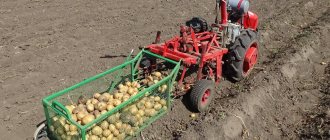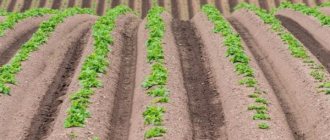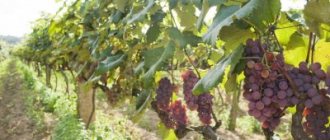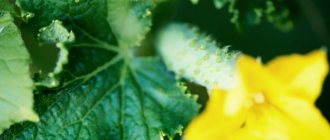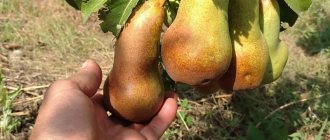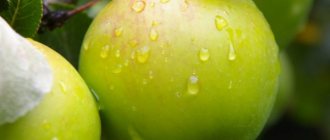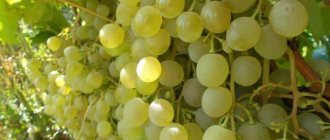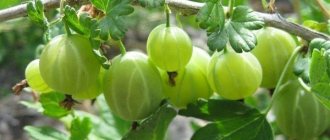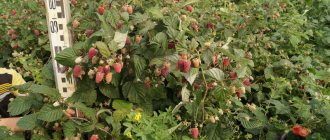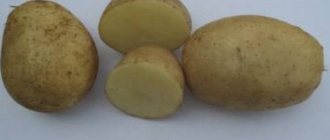Potato classification
An important criterion by which potato varieties are classified is the period of fruit ripening, and the purpose of the vegetable also plays an important role.
Classification of different types, taking into account the ripening period of the tuber:
- Early - a fruit that ripens in about 40 or 56 days. The period of possible growth and development of the fetus takes from 2.5 to 3 months.
- Mid-early. Young fruits are formed approximately 2 or 2.5 months after they were planted. The growing season averages from 3 to 3.5 months.
- Mid-ripening - potato fruits approximately 2.5-3 months after planting in the soil. The growing season takes 125-140 days.
- Late ripening - new tubers are formed approximately 2.5 months after they were planted. The growing season lasts more than six months.
Varieties of tubers according to purpose:
- table fruits - fruits with a pleasant taste and a pulp structure that does not tend to darken after peeling or damage, as a rule, are used for food;
- technical - the category includes medium and late types of potatoes, which contain starch from 15 percent, are used in industry, namely, to isolate starch, as well as industrial alcohol;
- feed - these include fruits with a high harvest rate, which contain a lot of protein;
- universal - fruits with an average ripening period, distinguished by taste and yield, as well as a structure that does not begin to darken after damage, are used for all purposes.
Note: for the production of semi-finished products, for example, crackers, chips, etc., potato varieties are selected that differ in starch content - at least 20%.
Potatoes for frying, mashing or salad
How potatoes behave during heat treatment depends entirely on the density of their pulp . There is a special classification of potatoes based on this criterion:
- A - potatoes with minimal starch content, which practically do not boil;
- B - slightly boiled;
- C - very boiling;
- D - Potatoes with a very high starch content.
If you're not sure which type you bought, cut one of the tubers in half and quickly rub the halves together. If droplets of water appear between them, you have a type A variety, and if the halves stick together, you are dealing with a type C or D.
The most boiled varieties for puree
Certain varieties of potatoes have a habit of literally “falling apart” during cooking, so they are ideal for dishes such as mashed potatoes. The best of them are considered to be:
- Riviera is an early, high-yielding variety. Tolerant of drought conditions, but sensitive to scab and late blight. The tubers are oval, the skin is thick, light yellow in color, the flesh is creamy and granular. The size of the tubers is 105–170 grams, the yield is high and stable, and with good care reaches 45 t/ha.
- Bellarosa is a relatively young variety that became widespread only in the early 2000s. Almost not susceptible to disease, resistant to chemical damage, and has high yield. The tubers are round, rough, reddish in color. The average weight of tubers is 115–210 grams, individual specimens can reach 700–800 grams. Harvesting takes place 50–60 days from planting. Productivity reaches 20–35 t/ha.
- Tiras is an early, relatively unpretentious and high-yielding plant. The tubers are oblong, with pinkish skin and superficial “eyes”. The weight of tubers can vary from 114 to 140 grams. The period from germination to technical maturity is 82–85 days. If all growing conditions are met, there is a chance to harvest up to 46 t/ha.
Potatoes tend to discolor when in contact with certain metals, so cooking them in aluminum or iron pans should be avoided.
Photo gallery: the most boiled potato varieties
The best potatoes for frying
It's hard to say who among us doesn't love delicious fried potatoes with a crispy crust. However, it often happens that potatoes after such heat treatment become not fried, but rather stewed. To avoid this trouble, it is better to find out in advance which varieties are most suitable for frying:
- Rosara is an unpretentious variety suitable for growing in any climate. The tubers are smooth, compact, almost identical in size. The peel has a pinkish or reddish tint, the flesh is yellow. It takes 2.5 months for potatoes to fully ripen. The average weight of tubers is about 90–120 grams, the yield ranges from 20 to 42 t/ha.
- Anosta is a Dutch potato that is successfully grown throughout the CIS. Resistant to most diseases, but very often affected by late blight. The tubers have a regular round shape, the peel and pulp are yellow. The weight of one potato is 71–134 grams. The variety is an early variety; it takes 70–75 days to ripen. It is considered quite productive, but there is no reliable information on this matter.
- Ariel is a very promising Dutch variety. It has a balanced taste, perfect for both personal consumption and sale. The variety is early ripening, 60–75 days pass from planting to harvest. Potatoes have a very high yield - from 22 to 49 t/ha, and it is possible to harvest twice per season. The tubers are smooth, neat, weight ranges from 80 to 170 grams. The peel is yellow, the flesh is light yellow or cream in color. The variety is resistant to most dangerous diseases.
When peeling potatoes, try to remove as thin a layer of skin as possible. This way you will retain much more nutrients.
Photo gallery: the best varieties of potatoes for frying
Salad potatoes
Salad (or table) potatoes are those that are best suited for preparing various salads. It contains very little starch and does not crumble when cooked. Salad potatoes are valuable because they do not darken after cooking and retain an excellent taste not only when hot, but also when cold.
Nowadays, varieties with red, blue and purple flesh have begun to be used for preparing salads and vinaigrettes. They not only retain the appearance of tubers after cooking, but also slow down oxidation processes in the body, thereby inhibiting aging. The brighter the color of the potato, the more nutrients it contains.
The most popular varieties of such potatoes are:
- Red Scarlet is an early high-yielding potato of Dutch selection. It has high resistance to most diseases, stores well, and easily tolerates dry conditions. The tubers are oblong, the skin is red, the flesh is yellow. The growing season is approximately 75 days. The weight of one tuber can reach 120 grams. The yield is quite good - approximately 27 t/ha. Red Scarlet potatoes are a Dutch variety.
- The French truffle is a very unusual variety with purple skin and flesh. Ideal for salads and vinaigrettes as it does not boil over. Potatoes of this variety need to be peeled only after they have cooled completely - then the inside will be black and purple with a pink center. The tubers are small, about 10 cm in length, average weight - 70 grams. The variety is late and has a low yield; it is grown on a small scale using manual labor, so these potatoes are quite expensive. The French truffle potato variety seems to be the most unusual of all varieties - it is grown in very limited quantities and by hand, so it is extremely expensive
- Annushka is a mid-season salad potato with high yield. The peel is smooth and shiny, yellow in color, the eyes are small, the flesh is yellow when cut. Potatoes of this variety have a pleasant taste, do not darken or become boiled. The growing season takes 80–85 days. Productivity varies from 21 to 51 t/ha. Resistant to most dangerous diseases, but susceptible to scab. The weight of one tuber is 100–200 grams. The Annushka variety is not overcooked and is not darker, which makes it an excellent ingredient for salads
To avoid discoloration of potatoes, try to peel and cut them immediately before cooking. If you can’t cook the vegetable immediately after peeling, place it in a bowl of cold water with a small amount of lemon juice. This simple technique will prevent the pulp from darkening and losing its shape.
Early varieties
Potatoes, which ripen in a short period of time, are divided into 3 more subgroups, namely: ultra- and mid-early, as well as early-ripening.
Early varieties include the following varieties:
And also Isle of Jura, Evolution, Madeira, Molly, Nandina, Natasha, Uladar, Early Morning, White Rose, Azora, etc.
This is a striking example of potato varieties native to Holland. Impala has a smooth but firm skin and sandy flesh. The eyes are smaller than average, the shape of the potato is large, oval, but sometimes round.
Starch – 12-14%, the weight of one specimen ranges from 95 to 150 g.
Potatoes can be planted in the southern as well as northern regions of Russia.
The Vineta variety of potatoes does not require special care conditions, but is distinctively tasty. It has medium friable pulp that is yellow in color. The fruits are oval, slightly oblong, sometimes round. The weight of one specimen is approximately 75-120 grams, but there are fruits weighing up to 400 grams.
Starch – 12-15%. The color of the skin can range from light brown to dark yellow.
The German variety Karatop is characterized by a round, sometimes oval shape with a thick but smooth skin. The mass of the specimen is approximately 85-140 grams. The pulp is granular in structure and light beige in color. The size of the eyes is small, they are almost invisible.
Starch – 13%. Potatoes are tasty, they are a table variety, but they are often used in industry.
A yellow variety of potato with a similar fruit color in cross section. The specimens are medium in size, weighing approximately 73-145 g. The fruits are usually elongated, oval in shape.
Starch – 11-16%. From one Jewel bush you can collect 15 or 20 tubers. It can be planted in any soil, because the variety does not require special care and is able to grow in central Russia.
This is a variety originally from Holland, distinguished by its taste and dense structure, which does not overcook for a long time. The color of the shell, as well as the fruit, is yellow and light lemon, respectively.
Starch – 11-14%. The average weight of an elongated specimen is approximately 105-130 g.
It is a German variety. Externally, it has an elongated, ellipsoidal shape and a dark yellow peel. The color in the section is golden. The average weight of a specimen is approximately 100 g.
They stand out for their taste and the quality of their pulp, which does not turn black after peeling. Potatoes can be planted in any area with moderate humidity.
A lemon-colored Dutch table variety with elliptical or spherical fruits. The weight of the specimen is approximately 80-130 g. Starch - 11.8-15%.
It has normal taste with minimal crumbling. The color in the section is lemon. It is recommended to plant potatoes only in warm soil.
Varieties of yellow potatoes: find out and choose
Potatoes have long become our second bread. Therefore, many gardeners grow it on their plots. This culture is represented by a huge number of different varieties, each of which has its own characteristics. In today's article, prepared by the editors of the site KustRoz.ru, potatoes (yellow variety) will be discussed, as well as their characteristics.
Potatoes with yellow flesh enjoy the well-deserved love of gardeners. The fruits are generous with carotene, moderately sweet, boiled, not bitter, and also not sour. And how happy the chefs are about the bright fruit!
It’s not for nothing that potatoes are called “second bread”. Don’t forget how many different dishes that can be prepared “from potatoes” were listed by the heroine of the film “Girls”? So, most of the enthusiasm related specifically to yellow potatoes. A sign of the quality of which is considered to be marketability - the connection between the tubers going for sale and the total volume of diluted products (measured as a percentage).
Article on the topic: Potato variety “Alova” - description and photo
Plus, yellow potatoes taste great. They are primarily influenced by the starch content (starch content), which is measured as a percentage. So, for example, in our case, starchy potatoes with strong flesh are usually suitable for cooking - these are almost all types with red and pink skin and a percentage of starch of thirteen to fifteen. For frying, fruits with yellow flesh and peel, as well as a starch content of twelve to fourteen%, can be used.
Where does the color yellow come from?
From scientific sources we learned that potatoes, both outside and inside, can be white, yellow, reddish and also blue. Moreover, the color of the pulp in cultivated species varies from white to yellow. Carotenoids give it a yellowish color of varying intensity.
It is interesting that potatoes with white flesh in their own biochemical structure also contain the indicated carotenoids - approximately from 0.014 to 0.053% of pigment, and with yellowish flesh - 0.11−0.40%. The species Forget-me-not, Rassvet Kiev, Horizon, Gorlitsa, Slavyanka were formed by involving species with yellow flesh in breeding work. Species with yellow tubers are known for an increased percentage of carotene, ascorbic acid, and amino acids.
It has been established that carotene has a very positive effect on vision, as well as the body as a whole. It is especially needed in the spring, when there is a particular deficiency of vitamins. Based on everything that has been said, we can confidently say that the use of such tubers helps to renew carotene reserves. Since it is soluble only in fat, this means that such tubers are richer in fat and do not crumble during cooking; they are softer and also healthier.
During scientific trips to the homeland of potatoes - Latin America, scientists were unable to see the use of potato species with snow-white pulp. Such species are simply rejected there and are eaten exclusively with yellow flesh.
Potatoes with similar characteristics have found wide use in Europe, for example, in Germany and the Netherlands. It is characteristic that the gene responsible for the color of the pulp is dominant. When crossing species with different flesh colors, there is a high probability that the offspring will be yellow. Actually, thanks to this feature, breeding scientists were able to create such a huge variety of species with yellow flesh.
Ukrainian breeders also make their own contribution to the treasury of species. In recent years, a number of promising and valuable types of potatoes have been developed in Ukraine, which are suitable for fresh consumption and for processing.
All of the listed varieties have a large list of valuable traits, are designed for domestic soil and climatic conditions, and are resistant to various types of diseases. They delight us with the highest level of harvest.
The nutritional value
The taste of potatoes depends not on the amount of starch (forage varieties are very rich in it), but on unsaturated fatty acids. For frying, soups and salads, potatoes with a low starch content are usually used, for mashed potatoes - with a higher one (for example, the Lorch variety).
Potatoes with white skin may have white or light cream flesh; yellow tubers usually have darker flesh. Accordingly, the most carotene in potatoes is yellow varieties with yellow flesh.
Varieties with yellow and cream flesh taste better
Potato varieties with yellow flesh
Below is a review of the best and most popular varieties of yellow potatoes, after studying which you can easily choose the best one for cultivation or consumption.
The most famous in the lands of the CIS countries. Main characteristics:
- early ripening, in the south you can inherit several harvests in one season;
- with proper watering and fertilizing, the yield is very high - three hundred and fifty c/ha;
- a large oval-shaped root vegetable (approximately two hundred to five hundred grams of fruit).
It grows poorly on the ground without fertilizing. It is recommended to grow it after legumes.
Rosara belongs to the early ripening varieties and is formed within seventy days. Used in modern and new industries for the production of dry raw materials. Main characteristics:
- the pulp is pale yellow in color;
- on average the fruit weighs approximately seventy to one hundred and thirty grams;
- the shape of the fruit is round, slightly elongated;
- holds its shape well due to the low starch content;
- yield level is five hundred c/ha.
Belongs to late types of potatoes. It matures completely and completely in one hundred ten to one hundred thirty days after germination. Main characteristics:
- very high yield, one hectare can produce up to twenty tons of potatoes;
- the color of the tubers is pinkish-golden;
- the weight of 1 fruit ranges from one hundred to one hundred and fifty grams;
- pulp is white-yellow;
- the food taste is stunning;
- susceptible to disease - late blight;
- has a high shelf life.
The plant is planted in the spring, when there is no longer any cold weather, but the soil still remains moist.
This is a mid-season type of potato of German selection, for table use. Adretta is distinguished by the excellent taste of the pulp. The plant is erect, the leaves are light greenish in color. The corolla of the flower is snow-white. The tubers are round-oval in shape with small eyes. The usual weight of a tuber is one hundred to one hundred and fifty grams. The pulp is yellowish in color and does not darken when cut or cooked.
The species has early tuberization. Stable against late blight, relatively resistant to viral pathologies.
An early ripening table type of potato. It enjoys fame due to its stable high yield (five hundred fifty to six hundred twenty c/ha) in the southern and central regions of Russia.
Tubers with smooth yellowish skin, light yellow very tasty pulp and small eyes. The usual weight of a tuber is ninety to one hundred and fifty grams. Positive qualities of the variety: Impala potatoes store well, are resistant to golden potato nematode and potato cancer.
A mid-early type of table potato. The tubers are uniform, attractive, with eyes of medium depth. The tubers are round in shape, large, with light yellow flesh and yellowish skin. The percentage of dry matter is 18.7.
The species tolerates heat easily, is perfectly stored, and is resistant to various damages. Doesn't boil over. Resistant to viruses and tuber blight. Moderately resistant to leaf torsion and common scab. Not resistant to potato nematode.
Zoned in the Central Black Earth and central regions. The tubers are round-oval, with yellow starchy pulp and yellowish skin. Such potatoes are perfect for making mashed potatoes, jacket potatoes, French fries, goulash, potato pancakes, etc. Boiled tubers have an excellent taste and do not darken.
The variety has complex resistance to potato pathologies. The highest yield is three hundred c/ha.
Mid-early (eighty to ninety days from germination to first harvest), productive variety from the Dutch company Agrico. These are potatoes for table use, as well as for the production of chips and French fries. Sante is the highest-yielding variety, which requires greater spacing between plants and rows when propagated.
Tubers of this variety are oval and large. The skin is yellowish, smooth. The pulp is light yellowish and does not darken when cut. The eyes are small and numerous. The percentage of starch in tubers is ten to fourteen. The nutritional quality is excellent. The advantages of the Sante variety: very high yield, excellent taste, good degree of immunity to diseases. Potatoes of this variety have good preservation and marketability.
Mid-early variety, high yield and good taste. It is not picky about soil composition and can be grown on light to medium-textured soils. Reacts well to mineral supplements. It is distinguished by early tuberization and rapid accumulation of yield in the first half of the growing season.
Related article: Potato variety “Miranda” - description and photo
Resistant to potato cancer pathogen. Resistant to wrinkles, streaking and leaf curl. Moderately susceptible to late blight, rhizoctonia and common scab. Susceptible to nematode. Resistant to mechanical damage.
The taste is good. The pulp softens slightly during cooking. Culinary type B. Suitable for frozen vegetable mixtures and preparing French fries. And also for soups, salads and frying.
Characteristics of the Breeze variety:
- ripening period - mid-early (80−90 days);
- the shape of the tubers is oval;
- peel structure - medium smooth;
- peel color - yellow;
- pulp color - yellow;
- eye depth - shallow or medium;
- starch content - 10.0−15.8%;
- yield per hundred square meters - 160−395 kg (maximum up to 451 kg);
- number of tubers per bush - 8−12;
- the average weight of 1 tuber is 97−154 g;
- marketability - 83−98%;
- keeping quality - 97%.
The appearance of the plant is of medium height, intermediate type, semi-erect. The leaf is large, intermediate type, green. The undulation of the edge is weak. Inflorescences are medium size, red-violet. Recommended regions for planting: Northwestern, Central.
This is an early variety for table use, produced by German breeding work. From the moment this variety is planted until the harvest is fully ripened, approximately eighty days pass. The Gala variety has large leaves, a potato bush of normal size, and weak flowering (white flowers). The weight of one tuber is eighty to one hundred and thirty grams. The average yield is two hundred and fifty c/ha. Maximum four hundred twenty c/ha.
This variety is exceptionally good for sale, since the yield of commercial quality tubers is up to 96%. The configuration of the tubers is oval, spherical, smooth, excellent for mechanical cleaning. Exceptionally resistant to viruses and diseases. Endowed with excellent taste. Excellent transportability and storage. Suitable for the vast majority of regions of our country.
- Advantages of the variety : unpretentious to soil and climatic conditions, with proper adherence to agrotechnical measures, it provides a high yield of high-quality tubers. Resistant to many diseases. Resistance to mechanical damage is very high.
- Disadvantages : low resistance to late blight and rhizoctonia. This type has quite a few disadvantages, especially if the growing recommendations are followed.
Luck
Root crops of the Udacha variety were bred by Russian specialists. Potatoes are early, ripen in 80 days, but they begin to taste them after 65-60 days. It is grown in fertile soil.
The optimal temperature for normal development of root crops is 22 C, but seedlings can be planted in cool soil at 6 C:
- average tuber weight 150-250 g; large potatoes. Up to 15 buds are formed in the nest;
- yield 450 kg/hundred;
- the crop exhibits moderate resistance to late blight on tubers and tops. It is recommended to take preventive measures against nematodes, treat the soil with insecticides, ash, and apply mineral fertilizers.
The crop is recommended to be grown in the Far East, in the regions of Eastern Siberia, and in the Urals. Root crops adapt well to both high humidity and dry soil. The soil must be monitored; waterlogging should not be allowed, so as not to provoke the appearance of fungus.
Yellow potatoes - which variety to choose
Potato varieties have a wide variety of taste characteristics, growing conditions, and care nuances. To choose the right variety, you must rely on the following parameters:
- growing conditions;
- disease resistance;
- productivity;
- purpose of cultivation.
According to this criterion, potatoes are divided into the following varieties: table (contain up to 18% starch), technical (contain above 16% starch), fodder (contain a lot of starch), universal (contain 16-18% starch).
According to their intended purpose, table potato varieties are divided into the following categories:
- A - suitable for making okroshka and salads;
- B - tolerates frying and boiling well (does not become overcooked);
- C - boils well. Suitable for serving whole;
- D - potatoes that boil very well. Suitable for making purees and baking.
When choosing a yellow potato variety to grow, you must first evaluate its taste characteristics. After all, all these varieties are varietal.
To grow yellow potatoes on your plot, you must adhere to the same agricultural techniques as when growing other varieties. It is yellow potatoes that should be planted to prepare a variety of culinary masterpieces.
The best varieties for different geographical locations
The variety of early varieties is amazing. To simplify their choice, you can proceed from which varieties are more suitable for cultivation in certain regions.
The best varieties for central Russia:
- Friendly;
- Ural early;
- Luck;
- Sosnovsky;
- Belorussian;
- Slav;
- Vyatka.
For cultivation in the Moscow region, it is worth choosing varieties that exhibit high resistance to diseases and are unpretentious to weather conditions. These include:
- Spring;
- Zhukovsky;
- Timo;
- Nevsky;
- Lugovskoy.
If potatoes are grown in the North-Western regions, then they must be resistant to soil and climatic conditions. Based on this criterion, it is worth choosing the following varieties:
- Amorosa;
- Zhukovsky early;
- Impala;
- Karatop;
- Latona;
- Prigozhiy 2;
- Fresco;
- Adretta;
- Christmas;
- Sante;
- Aurora;
- Romano.
So, early potato varieties are presented in a wide variety. In turn, they are divided into ultra-early, early-ripening and mid-early. To ensure that you get a good harvest, experienced gardeners recommend planting several different varieties in one area at once. You can harvest early potatoes for food when the tops are green, when the skin is still very thin.
0
0
Copy link
Unusual delicacy
Yes, potato varieties that are distinguished by the intense purple color of their flesh are considered delicacy. Not only because of their non-standard appearance, but also because of their unusual taste.
It has a pronounced nutty flavor, which, according to fans of gardening experiments, does not spoil this root vegetable at all, on the contrary, it gives it a piquancy.
The unusual coloring of the flesh is not the result of the work of genetic engineers, as one might easily think. It is of natural origin. The pigment was obtained from vegetables growing on the equator and in Africa, and as a result of numerous crossings, it acquired the degree of a species characteristic.
Where did he come from?
It all started with the work of breeders to develop new diet varieties of this root vegetable. Interspecific hybrids were used in the formation of new varieties. The initial material was taken from the maternal forms of cultivated species growing in South America. The basis was the varieties bred by Ukrainian breeders.
The use of the classical method of sexual hybridization resulted in varieties whose flesh has varying degrees of color - from pale lilac to dark purple.
Today, about 120 intermediate samples are involved in the selection process, which is an excellent result and guarantees in the future the production of new fixed hybrids with purple flesh.
It is no secret that potatoes with a standard color of flesh can be classified as a dietary product with a big stretch, since they contain a large number of calories. But the colored one is not so dangerous in this regard; moreover, it has a lot of useful properties that are inherent in the standard white-yellow varieties to a lesser extent.
Color means health. Benefit!
According to research by nutritionists, colored foods have different effects on the human body. Of course, they could not ignore such a phenomenon as completely purple potato tubers, and, after carefully studying it, they came to the following conclusions.
- Purple potatoes lower blood pressure. Moreover, it is so significant that the product is not recommended for frequent use by people suffering from hypotension. But for hypertensive patients this is a real medicine.
- The vegetable contains more antioxidants than non-colored varieties. If you regularly eat purple potatoes, it slows down the aging process of the body. Of course, you won’t be able to get younger from the “magic root vegetable,” but you can delay old age somewhat.
- This vegetable contains an increased percentage of vitamins in the complex most required by the body. Its basis is the two most important vitamins for health - C and E, as well as a number of unique carotenoid substances. They help synthesize vitamin A, maintain water balance and have a positive effect on the endocrine system.
- When consuming this root vegetable, vision sharpens, the walls of blood vessels become stronger and more elastic, and the risk of atherosclerosis and cancer decreases.
Article on the topic: Potato variety “Giant” - description and photo
This vegetable contains a lot of anthocyanins, which are powerful antioxidants. It turns out that by eating purple potatoes, we increase immunity, fight colds, lower blood sugar and lose weight, because they contain less starch than yellow or white ones.
A purple potato tuber absorbs three times less nitrates from the soil, and there is as much vitamin C in two such potatoes as in one lemon.
We grow the most delicious potatoes on our own plot
So, we figured out what varieties of potatoes should be chosen for preparing certain dishes. But what if you want not only to buy a delicious variety of potatoes, but to grow them on your own plot?
First of all, you should decide which specific variety you prefer, and then study the agricultural technology of growing it in as much detail as possible. Be sure to take into account the individual characteristics of the site - the composition and acidity of the soil, cultivation technology, etc. Then think about which growing method will be most preferable for you - traditional, planting under straw or in ridges, etc. Keep in mind that the characteristics of a particular variety are genetically embedded in it, but may vary depending on the area and agricultural technology. In other words, even if you take a very productive variety, but grow it in unfavorable conditions, without taking into account individual characteristics, the final harvest will be scanty.
Don’t forget about fertilizing - apply all the necessary fertilizers to the soil in a timely manner, but do not overdo it. If the soil is poor in minerals, any variety grown on it will be tasteless. In addition, with a lack of nutrients, potatoes are much more susceptible to various diseases. But an excess of minerals will not bring anything good. Tubers saturated with fertilizers will change their boiliness, become mealy and acquire an earthy aftertaste. Do not forget that excess nitrogen contributes to the accumulation of nitrates in potato tubers, which not only give the vegetable an unpleasant bitter-salty taste, but are also extremely harmful to health. To neutralize the harmful effects of nitrogen fertilizers, add ash to the soil along with them.
The most delicious vegetable is considered to be grown on soils fertilized with ash and humus.
When growing sawdust or fresh straw, add nitrogen to it. And remember about complex fertilizers - they will provide potatoes with all the necessary substances.
An important aspect that concerns the taste of potatoes is their storage conditions, since during this period of time biochemical processes continue in the tubers and ripening occurs. Some varieties may become tastier during storage, while others, on the contrary, lose their taste. If the tubers are exposed to low temperatures during storage, the starch they contain will turn into sugar, and as a result the potatoes will acquire an unnatural and unpleasant sweetness. And at excessively high temperatures, harmful substances are formed in the tubers.
When choosing potatoes, consider not only your own preferences in the taste of the fruit, but also the capabilities of your plot
A few planting secrets
- Try not to plant potatoes in the same area for a long time, since this practice greatly increases the risk of infection with potato pests and various diseases. In addition, this leads to soil depletion. Therefore, always alternate crops - plant potatoes after cabbage, legumes, phacelia, perennial grasses or oil radish. Avoid planting potatoes after garden strawberries: since their diseases and pests are identical, the potatoes will almost certainly become infected with some disease, which will greatly affect the harvest.
- In warm weather, potato tubers germinate in 2–3 weeks. In cold weather, the germination process slows down, taking 3–4 weeks. Slowing development leads to the fact that potatoes form a powerful root system and the yield increases. Based on this consideration, try to plant tubers early. However, do not overdo it - if planted too early, late blight will begin to appear on the plants.
- Planting potatoes in ridges gives twice the yield than the traditional method. The planting depth should be from 12 to 15 cm, the density should be 350–400 bushes per hundred square meters. Row spacing should be at least half a meter. Planting under straw also gives very good results, but it will be more labor-intensive and costly.
- Pay attention to the correct selection of planting material. Over time, potatoes tend to degenerate, resulting in reduced yields.
- It is considered optimal to plant 40% of early potato varieties, 35% of medium and 25% of late varieties.
- Be sure to loosen the soil between the rows and around the potato bushes. During dry periods, this should be done less often, and during excessively wet periods, as often as possible. Keep weeds away.
- Promptly treat late blight and Colorado potato beetles, since they are the ones that cause the most harm to potatoes.
Features of cultivation
While some advantages can be noted in the properties, the same cannot be said about agricultural technology, since purple potatoes are much more demanding than their colorless “brother” and require special care.
- Firstly, it is more susceptible to scab and has a low degree of resistance to late blight.
- Secondly, the Colorado potato beetle - the scourge of all potato growers - primarily attacks plantings with purple-fleshed tubers ( More details: Folk remedies for combating the Colorado potato beetle)
- Thirdly, if you propagate purple varieties with “eyes”, the tubers will inevitably and catastrophically become smaller, turning into a wild-growing form.
Work continues. Today, 30% of all existing varieties are already involved in the selection process. This will make it possible to soon develop a purple root crop that is not only resistant to pests, but also immune to diseases of the family.
Otherwise, the agricultural technology of colored potatoes does not differ from that generally accepted when growing this vegetable. It does not require special conditions.
- Fertilizers for potatoes when planting
- Weeding and hilling.
- Regular watering throughout the growing season.
- Disease and pest control.
- Productivity depends on the care and composition of the soil. The most unsuitable soil for purple potatoes is loam. And the best ones are fertile and breathable, with a light structure.
Skoroplodny
The Skoroplodny variety was created by Russian plant breeders. The culture is early, ripens up to 70 days. The first digging is carried out at 55 days. Root crops are left in the ground to ripen. Vegetables are grown in the Urals, in the Volga-Vyatka region.
Good performance is observed when grown on loamy soils:
- weight of one tuber – 128 g;
- yield 270 kg/hundred;
- The peel is yellow, the fruits are even, smooth, universally used.
The culture is resistant to cancer and scab, but resistance to late blight is average. Before planting, the seeds are treated with copper sulfate. For nematodes, the drug “Quadris”, “Topaz” or “Nitrofoska” is applied to the soil.
How to cook?
Cooking unusually colored potatoes is no different from regular ones.
Heat treatment, and all the beneficial properties remain in the vegetable, even if you boil it in salt water. Purple puree or chips look original. French fries, pancakes, stuffing, salad. The taste differs from the traditional one for the better. The nutty flavor is noticeable more or less in different varieties, but it is present.
Fried cauliflower potatoes
Variety "Vitelot"
In the original – Vitelotte – one of the most popular varieties with blue-violet pulp. It is also called “Negress”, “French truffle”. The tubers have an elongated shape. The core is intensely colored. The peel is dark. The mass of tubers is small - on average from 70 to 100 g. Late variety - ripening period up to 110 days. Potatoes store well and for a long time, retain their color under any heat treatment, and have a rich taste.
Bryansk reliable
A mid-late variety for universal use, used for preparing almost any dish. The tubers are oval-round with a smooth skin and eyes of medium depth. The pulp is dense and juicy. The yield is high, which, combined with the high starch content, sets this variety apart from the rest. The “reliable” name is justified by the fact that potatoes are practically not affected by rhizoctonia and scab. In addition, it is not favored by Colorado potato beetles, and it avoids severe viral diseases. What you should be wary of are nematodes and late blight.
| Purpose | Productivity (kg/100 sq.m) | Tuber weight (g) | Maturation (days) | Flesh color | |
| 170-250 | 80-120 | 100-110 | White | ||
Variety "All Blue"
This is the direct name, translated from English All Blue, from which it immediately becomes clear what color the flesh of this vegetable is. Although, it is more blue-violet than blue, and the peel is dark purple. There is a light ring between the skin and the pulp.
The variety is mid-early, ripens in 80 days. The tubers are rather large - up to 200 g, but they are not stored for very long. This variety is widespread throughout Europe, it is just beginning to approach us, but it is quickly gaining popularity because it has an excellent taste. It is considered dietary in properties. It contains a lot of antioxidants. The interesting color is completely preserved during frying and baking and fades a little when boiled.
Dependence of potato properties on skin color
Confusion sometimes arises with the classification of potatoes by skin color: tubers with light beige or light cream skin are usually called white. Therefore, in descriptions such varieties may be indicated as either white or light yellow.
There is an opinion that varieties with white skin are less shelf-stable. There is logic in such reasoning, since many varieties with pale cream (white) skin have very thin skin, which impairs the keeping quality of the tubers. In addition, late varieties of potatoes, which can be stored for a long time, have dark skins. But there are exceptions to the rule: for example, Olvia potatoes, despite their very light skin, keep well until spring.
Variety "Explosion"
This variety is Explosion, so named for its early and rapid fruiting. Early ripening, which will delight you with a harvest within 65 days after planting, has pure purple pulp and the same peel.
The weight of the fruits varies - from 100 to 150 g. The shape is elongated. The difference between this variety and other purple varieties is its increased resistance to disease. It is also characterized by high productivity. You won’t be able to store the fruits for a long time, but you can cook anything from them. You can even eat the vegetable raw, for dietary salads.
Gypsy
This is a rather rare variety, which is sometimes mistakenly called Slavyanka and Kubinka, and in some regions the old-fashioned names are Negritenok and Chugunka. The abundance of names already indicates its popularity and productivity. The tubers have a characteristic eggplant color and flesh with purple veins. The plant requires fertile soil and constant moisture. The taste of the fruits is excellent; almost any dish can be prepared from them. True, this needs to be done within 2-3 months - the capricious Gypsy is not stored for a long time, and over time it acquires an unpleasant aftertaste. And for some reason the Colorado potato beetles don’t like the crop, and it avoids late blight.
| Purpose | Productivity (kg/100 sq.m) | Tuber weight (g) | Maturation (days) | Flesh color | |
| 320-400 | 90-150 | 70-90 | White with veins | ||
Variety "Lilac"
This variety was bred in Russia by domestic breeders. Mid-season, ripens in 95 days. The fruit has purple flesh and skin. The shape is oval-round. Weight - up to 80 g. It has an average yield, good shelf life and resistance to scab and cancer. The taste is excellent, with a hint of almond. It is considered a valuable dietary product.
When should you choose such potatoes for growing?
Potatoes for planting can be purchased at markets or in specialized stores. The latter option, although more expensive, is safer. Specialists will provide you with a certificate that guarantees the suitability of the tubers for planting.
Seed white potatoes are purchased a month before planting, just during this time you will have time to germinate and sort out the potatoes. Early and mid-season varieties are suitable for cultivation in Russia.
Variety "Peruvian purple"
Purple Peruvian is the original name of this variety, which arose as a result of two centuries of selection by potato growers living in the highlands of the Andes. Just think, for two hundred years people have been trying to develop these elongated eyes covered with many eyes for humanity. For what? So that people can enjoy a healthy and dietary product by replacing regular potatoes, which are called “second bread” in many CIS countries. Late variety. Ripens in 100-110 days. And it is no different in size - the average weight of a root crop is 80 g. The yield is also not the highest. But the taste is wonderful. Walnuts and hazelnuts are clearly visible. A very big difference from regular potatoes. Just a new look at the product.
The variety is stored very well and for a long time. It also transports well. And it retains all its beneficial dietary properties almost until spring. It does not lose them during heat treatment. Real food is medicine.
Kiwi
The Kiwi culture was developed by plant growers in the city of Zhukovsky. Late variety. They wait 130 days for the harvest. Its uniqueness lies in the fact that the plants are resistant to late blight on tops and tubers and do not suffer from cancer. They are not attacked by the Colorado potato beetle.
The culture is photophilous. They find a sunny area for her in the garden. Experts guarantee a high yield of vegetables. From 1 kg of seedlings you get 20 kg of root crops. Genetically modified variety.
White potatoes can be grown both in open ground and in a greenhouse. For root crops, a certain microclimate is maintained. Temperature 18-22 C, humidity 65%. The greenhouse is regularly ventilated so as not to provoke the development of gray rot and late blight.
The protective shell is dense, light brown with dark speckles. The pulp is white. High storage capacity is noted. There is almost no culling. Vegetables remain until the next harvest. Externally, potatoes look like an exotic fruit.
Potatoes with light flesh are cultivated in all regions. It is necessary to choose a variety whose characteristics correspond to a certain climatic zone. Early white potatoes are intended for quick use. Vegetables of mid-season and late varieties are stored for the winter.
Variety "Adirondack Blue"
The name in its homeland is Adirondack Blue. Bred at Cornell University. It is distinguished by its highest yield and oval-rounded fruits, the average weight of which is about 100 g. The best purple chips can be obtained from the tubers of this variety. Ripening time is average - about 95 days. It is not resistant to diseases and has an average shelf life. But it contains enough antioxidants to make it preferable to traditional neutral-colored potatoes.
Should you grow purple potatoes? Definitely yes. And even if you don’t have room to roam around on your property, and no room for experiments, select a bed for a vegetable of a new color, displacing the good old potatoes. Select variety and ripening time. For example, if you traditionally grow a specific variety of winter potatoes, plant several rows of purple early ripening ones. And see what happens.
Already today there are private farms (not industrial ones) that have switched entirely to growing colored potatoes. It doesn't have to be purple. There are pink, blue, orange varieties. Each of them has its own exceptional beneficial properties. And the table and menu become more interesting, colorful and festive. Color is health. Why not grow a healthy product, even if it is an unusual purple color?!
